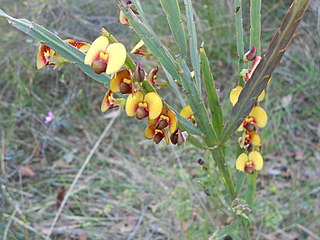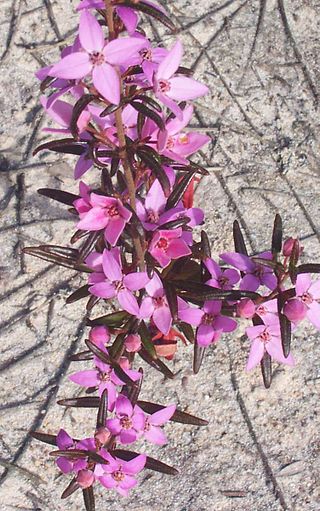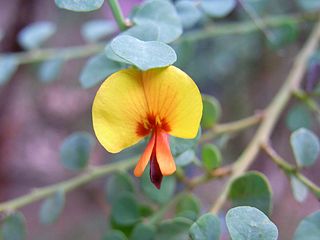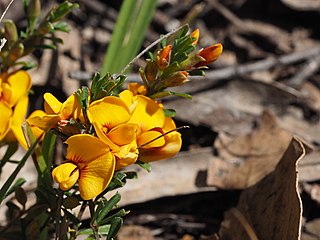
Bossiaea ensata, commonly known as sword bossiaea, is a species of flowering plant in the family Fabaceae and is endemic to south-eastern continental Australia. It is an erect or low-lying, glabrous shrub with flattened branches, flattened, winged cladodes, leaves mostly reduced to small scales, and orange-yellow and red flowers.

Boronia ledifolia, commonly known as the Sydney boronia, showy boronia or ledum boronia, is a plant in the citrus family Rutaceae and is endemic to south-eastern Australia. It is a shrub with simple or pinnate leaves which have a strong odour when crushed, and pale to bright pink flowers. Although difficult to propagate, this boronia is a popular garden plant.

Eucalyptus ligustrina, commonly known as the privet-leaved stringybark, is a species of shrub, mallee or small tree that is endemic to New South Wales. It has rough, stringy bark, lance-shaped to egg-shaped adult leaves, flower buds in groups of between seven and fifteen, white flowers and hemispherical or shortened spherical fruit.

Bossiaea rhombifolia, is a species of flowering plant in the family Fabaceae and is endemic to eastern Australia. It is an erect, glabrous shrub with diamond-shaped, more or less round or broadly egg-shaped leaves, and yellow and red or pinkish flowers.

Mirbelia speciosa is a species of flowering plant in the family Fabaceae and is endemic to eastern Australia. It is an erect shrub with narrowly linear leaves arranged in whorls of three, and bluish-purple flowers usually arranged singly in leaf axils.

Philotheca myoporoides, commonly known as long-leaf wax flower, is a species of flowering plant in the family Rutaceae and is endemic to south-eastern Australia. It is a shrub with sessile, oblong to egg-shaped, glandular-warty leaves and white to pink flowers arranged singly in leaf axils. Prior to 1998 it was known as Eriostemon myoporoides.

Zanthoxylum nitidum, commonly known as shiny-leaf prickly-ash, tez-mui or liang mian zhen, is a species of flowering plant in the family Rutaceae. It is a woody climber with prickles on the branchlets, thick, cone-shaped spines on the trunk and older branches, pinnate leaves with five to nine leaflets, and panicles or racemes of white to pale yellow, male or female flowers in leaf axils and on the ends of branchlets.

Darwinia diosmoides is a species of flowering plant in the myrtle family Myrtaceae and is endemic to the south-west of Western Australia. It is a dense, erect shrub with linear leaves and more or less spherical heads of white flowers.
Grevillea capitellata is a species of flowering plant in the family Proteaceae and is endemic to the Illawarra region of New South Wales. It is a low, dense mounded or prostrate shrub with narrowly elliptic to oblong leaves, and dull, deep crimson to dark maroon flowers.

Zanthoxylum rhetsa, commonly known as Indian prickly ash, is a species of flowering plant in the family Rutaceae and occurs from India east to the Philippines and south to northern Australia. It is a deciduous shrub or tree with cone-shaped spines on the stems, pinnate leaves with between nine and twenty-three leaflets, panicles of white or yellowish, male and female flowers, followed by spherical red, brown or black follicles.

Philotheca myoporoides subsp. myoporoides, commonly known as long-leaf wax flower, is a subspecies of flowering plant in the family Rutaceae and is endemic to south-eastern continental Australia. It is a shrub with oblong to elliptic or egg-shaped leaves and white or pink flowers arranged in groups of three to eight in leaf axils.

Pultenaea capitellata, commonly known as hard-head bush-pea, is a species of flowering plant in the family Fabaceae and is endemic to south-eastern continental Australia. It is a sprawling to prostrate shrub with elliptic to broadly egg-shaped leaves, and yellow to orange flowers with a red to purple keel.

Pultenaea euchila, commonly known as orange pultenaea, is a species of flowering plant in the family Fabaceae and is endemic to eastern Australia. It is an erect shrub with glabrous foliage, narrow egg-shaped leaves with the narrower end towards the base, and orange-coloured flowers arranged singly or in small groups near the ends of branchlets.

Pultenaea microphylla is a species of flowering plant in the family Fabaceae and is endemic to eastern Australia. It is an erect to prostrate shrub with narrow egg-shaped leaves with the narrower end towards the base, and clusters of up to ten yellow to red flowers with reddish markings.

Bossiaea lenticularis is a species of flowering plant in the family Fabaceae and is endemic to eastern New South Wales. It is a slender, spreading shrub with mostly circular leaves, and yellow and red flowers.

Bauera capitata is a species of flowering plant in the family Cunoniaceae and is endemic to coastal eastern Australia. It is a small shrub with trifoliate, usually lobed leaves and sessile, deep pink flowers with twelve to fifteen stamens.
Olearia elaeophila is a species of flowering plant in the family Asteraceae and is endemic to the south-west of Western Australia. It is a small shrub with scattered linear leaves, and white or blue and yellow, daisy-like inflorescences.
Olearia persoonioides is a species of flowering plant in the family Asteraceae and is endemic to Tasmania. It is a bushy shrub that typically grows to a height of 1.0–1.5 m. Its leaves are arranged alternately, oblong or egg-shaped with the narrower end towards the base, and 19–38 mm (0.75–1.50 in) long. They are shiny green on the upper surface and covered with silvery hairs on the lower side. The heads or daisy-like "flowers" are arranged in leafy panicles with 3 to 8 white ray florets surrounding 10 to 12 disc florets. Flowering occurs in January.

Leucopogon capitellatus is a species of flowering plant in the heath family Ericaceae and is endemic to the south-west of Western Australia. It is an erect, more or less glabrous shrub that typically grows to a height of 0.2–1 m. It has linear to lance-shaped leaves longer than about 12 mm (0.47 in) long, tapering to a rigid point on the tip. The flowers are borne on short spikes on the ends of branches or in leaf axils on short side branches, with small bracts and bracteoles about half as long as the sepals. The sepals are broad, about 2 mm (0.079 in) long and the petals white and about 4 mm (0.16 in) long, the petal lobes longer than the petal tube.

Pimelea floribunda is a species of flowering plant in the family Thymelaeaceae and is endemic to the south-west of Western Australia. It is a shrub with narrowly elliptic to egg-shaped leaves arranged in opposite pairs, and drooping, head-like clusters of white or cream-coloured, tube-shaped flowers.

















